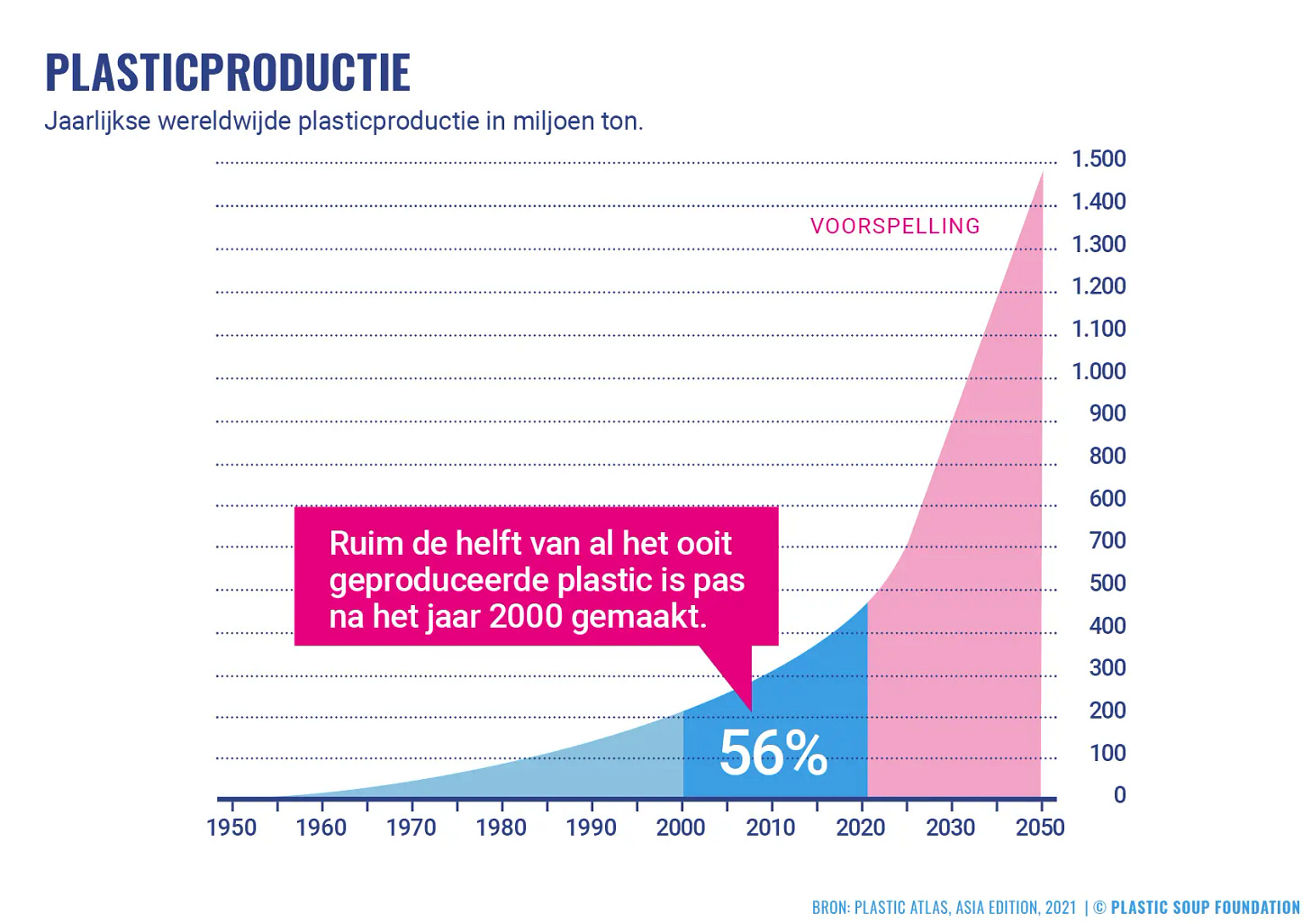Plastic is made up of endless repetitions of identical molecules, similar to episodes of a soap opera. Being perfectly homogeneous, plastic can be shaped at will just like a congregation of good soldiers, prisoners or consumers. You can think of it as a symbol of modern civilization. Left-right, left-right! Forward, troops, to the mall!
A model of the polimer chain of polyacetylene. Source: Wikipedia
The inquisitive human spirit had already taken steps towards artificial materials in the 19th century, but the real boom began in the early 20th century with the first fully synthetic player, bakelite. It’s now considered a classic, sought after by collectors. Bakelite can look almost like ivory or wood with pretty colors and patterns and is pleasant to the touch; it’s somewhat like a transitory step between old, obsolete materials and noble polyethylene.
Most plastic is made of crude oil, this marvellous substance we’re sucking from the depths of the Earth and burning at an ever increasing rate. Producing plastic saves the crude from being burned, having a positive impact on the environment. The thousand kinds of modern plastics can be divided into seven main classes, reflecting their magical nature. The most common everyday plastic is polyethylene with several varieties. Some critics point out that polyethylene terephthalate, affectionately known as PET, can release antimony, the sister of arsenic, if stored for long periods or at high temperatures. Fortunately, no one examines how it’s stored, so it’s all right to store beverages in PET bottles. Whew! You can happily take home your 10-piece well water PET-bottle package wrapped in another piece of strong plastic. After all, it’s so much more modern than turning on the tap at home. Of course, in new houses, water pipes are also made of plastic. Progress cannot be stopped!
Source: Moshe Harosh, Pixabay
Another unjust complaint concerns vinyl, a classic kitchen floor covering in poor homes. This substance is toxic not only while being manufactured and after degradation, but also while in use. It’s therefore employed — among numerous other things — to make children’s toys and medical tubes in order to make the population more resistant to poisons. The European Community acknowledged the toxicity of vinyl as early as 2000 and should have banned it under its own laws, but this time The Bureau is taking a refreshingly flexible approach. It’s so liberating when rigid bureaucrats show some understanding! After all, manufacturers also have to make a living, and all that whining is not sexy anyway.
We could produce perfectly harmless plastics from natural materials such as cellulose, which would biodegrade completely, but then where would the oil industry’s profits be? I bet those green complainers haven’t thought of that! No one should wish to see all those bankers queuing up at the food bank with plastic bags in their hands. Or having to make a shack out of plastic tarps, as in Gaza between two bombing raids. Yet the very fact that such things are possible shows the wide range of uses for plastic. Fortunately, the volume of this great material is increasing every year!
Actual and projected plastic production in million tonnes per year. More plastic was produced on Earth between 2000 and 2020 than the total amount before 2000. Source: plasticsoupfoundation.org
Plastic is like a geisha that satisfies your every whim. She’s willing to assume any position that you ask her, impersonating eyelashes or I-phones, buckets or baby toys, fridges or fishing rods, rabbit collars or roofs. Can you imagine your life without plastic? Plastic-free meetings are only organized by crazy hippies who are willing to carry heavy canvas into their camp. While they can use matches instead of lighters, wooden toothbrushes are really hard to find and they will have no ball-point pens to write their subversive proclamations. Computers or phones are out of the question, together with simple objects such as flaslights. Let the eyes of those backward morons fall out! They are lucky enough that clothes are not mandatory in a hippie gathering as most fabrics nowadays are also plastic. Not all of them, of course, as pretty as these vinyl pants.
Source: Ralph Schulz, Wikipedia
Plastic objects have a number of advantages compared to their outdated biological predecessors. Plastic flowers never wilt and are much larger and more colorful than natural flowers. Plastic lawns needs no watering, mowing or weeding. Plastic trees shed no leaves in the fall to be raked. Worrying about the chemical industry’s complete destruction of nature is thus uncalled for. Can’t we produce any number of beautiful plastic plants and animals? Beside plastic Jesuses and dwarfs, there already are a number of picturesque plastic flamingos, cows and storks decorating front lawns.
Another huge positive feature of plastic is its resistance to pests. You will never have to worry about a synthetic silk scarf being chewed by moths. Not even a synthetic moth! Plastic limbs will not develop calluses and plastic eyes will not shed tears. Even if your plastic crocodile sheds tears, it will never be corroded by them.
Mechanical parts made of plastic are also very useful as they break easily at which point you can buy yourself a brand new object. What a gift! Beside all these practical advantages plastic is also an inspiration for art. The adventures of Maci across centuries are recounted in this epic drama. The story of this bear-shaped plastic honey container is unfortunately only available in Hungarian. Is it time for you to learn the language? The main artistic role of plastic, however, is in the beau arts, serving as material for innumerable aesthetic pieces.
Source: Vinson Tan ( 楊 祖 武 ), Pixabay
Perhaps the most useful property of plastic is its extremely long life. We must admit that plastic soon ceases to exist as the object it was meant to be. A plastic bag is only a bag while you’re taking home your three pieces of tomatoes in it. Once you rip it open and throw it away it becomes garbage. In the form of rubbish, however, it will continue to exist for an extremely long time, providing work, among others, for garbage collection companies. In Italy, for example, these happen to be operated by the mafia, the very backbone of society. The poor of the Third World can also make a living from the garbage sent by rich countries where they can search for usable and recyclable objects while strengthening their immune system. Some companies also advertise degradable plastic, by which is meant that the object in question breaks down into smaller and smaller pieces and is no longer visible. More recently, recycling has become popular, which means that a few percentage of the plastic produced is recycled to make more plastic that is no longer recycled.
The most common, advanced use of plastic is packaging. Our planet is wrapped in an atmosphere, our countries in barbed wire, our cells in cell membranes, our very selves in skin and clothing. Why shouldn’t thin slices of artificial cheese be wrapped tastefully in polythene foil, then five of those in another piece of plastic foil, then two of the former in a third piece of plastic foil? Of course, that’s just what you see. The packages of packages of packages of packages were wrapped in more plastic, it’s just that the big wrappers had already been thrown out in the shop. And throwing out food wrapped in plastic is so much more hygienic!
Source: https://mavitecgreenenergy.com/applications/packed-food-waste-2/supermarket-waste/
The plastic bag is a famous achievement of our time providing a truly easy life for people. You don’t even have to ask for it, everything you buy is automatically placed into The Bag, even if the goods are already wrapped in plastic. Scientists are keen to understand how the human race has survived for thousands of years without The Bag. How did our ancestors carry the things they needed? Their arthritic pains must have been caused by the carrying of baskets and other heavy containers. Researchers have demonstrated that the lack of plastic bags played a significant role in the collapse of the Roman Empire. Not having a rust-protected container for metal objects looted proved disastrous at the end. There still are some people who carry bags in their pockets and backpacks for any goods they might buy, but we can see that such preparation would be an unbearable sacrifice for the masses. And squeezing out the remnaints of liquid, sticky, gooey stuff brought home in The Bag such as strawberries, pickled cucumbers, cottage cheese, is a particular delight for two-year-olds.
A worthy brother of The Bag is the plastic bottle, an excellent container which is not soluble by its contents. OK, only slightly soluble by acidic things like Coke or carbonated mineral water, but in today’s world so riddled with problems every solution is welcome. Coca-Cola Company produces 167,000 plastic bottles every minute, or nearly 88 billion a year. Let’s see Greenpeace beat that! If the bottles were lined up in rows, an ant could walk back and forth to the Moon more than 30 times on the resulting pathways. A plastic ant, of course, as only plastic can withstand space conditions.
We don’t know whether plastic is found on other planets, and if so, how much of a role it plays. According to philosophers, it’s highly probable that entire plastic celestial bodies orbit the sky. On our planet, plastic, among all its other uses, is a favourite food of sea turtles, whales and birds. You wouldn’t want to deprive them of this delicacy, would you?
Source: newzealandecology.org
Of course, it’s not only ignorant animals that consume plastic, but also us, enlightened Homo sapiens. I don’t mean food enriched with tasty additives, just the plastic molecules that enter our bodies from packaging, from the air, from food. With so many microplastic particles now in our organs, including our brains, we are effectively on the road to becoming plastic. The next step, which many of our fellow citizens have already taken, is that of the mall babes with their plastic smiles and synthetic breasts or mall dudes with their plastic muscles and artificial purr. Completely synthetic women are mostly employed in Japan, a place known for widespread sexual frustration. Logic would suggest that, even if not as popular, there must also be plastic gentlemen with pumpable penises. And in the age of three-dimensional printers, the impossible is no longer impossible! Soon we will be able to create a plastic version of ourselves, with our nose hairs, narcissism, hemorrhoids, dyslexia, all our obsessions and compulsions, and finally be able to get rid of that flabby, troublesome cytoplasm.









